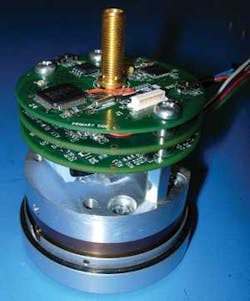Yorkshire Water tests world’s first vibration energy-harvesting microgenerator
A research and development project undertaken by a UK company is testing an innovative wireless and battery-free sensing technology, which increases plant efficiency through low-cost condition monitoring.
Peter Boruszenko, Roy Freeland, Martin Tillotson
Yorkshire Water’s Esholt Waste Water Treatment Works in Bradford, England, is currently conducting a trial of the world’s first practical vibration energy-harvesting microgenerator, PMG7.
The microgenerator, which powers wireless, battery-free devices capable of sending large amounts of critical data, will enable Yorkshire Water to increase plant efficiency through advanced, low-cost condition monitoring. It is also expected to considerably reduce machine repair costs by allowing improved pro-active maintenance whilst reducing the risk of compliance failures.
The trial is part of a £120,000 (US$ 226,000) research and development project undertaken by the water company to optimize its facilities and provide better service for its customers. Integral to the project is increasing reliability of its equipment. The company has previously installed conventional hard-wired systems to send and record performance data, but these were difficult and expensive to install, and proved unreliable.
Through the water company’s close links with The University of Southampton in the UK, it became aware of the spin-out company, Perpetuum, and its groundbreaking vibration energy-harvesting technology. Perpetuum’s PMG7 microgenerator is the enabling technology that powers S5NAP, wireless sensor nodes developed by RLW Inc of State College, Pennsylvania, USA. RLW Inc had originally selected an early prototype of the microgenerator for a project for the Office of Naval Research. Its S5NAP records and transmits vibration and temperature data using only the existing vibration of industrial equipment to power itself and as a result it eliminates the need for additional power supply.
“We are very interested in how new technologies can help us improve efficiency,” said Martin Tillotson, manager of research & development, Yorkshire Water. “We decided to conduct a trial, the first phase of which would be to ensure the microgenerator produces enough energy to power the sensor nodes and reliably transmit data. We also needed to be confident that the device would transmit data back to a central hub without distortion or interruption.”
In November 2005 six devices were installed on motors and blowers in the waste incinerator’s plant. This environment was chosen because it is especially harsh; many platforms and steel works create potential for interference to the data signal. Each piece of equipment has a unique signature vibration reading and the devices were installed to measure and transmit the vibration spectra. Once the system is fully developed, operators would be alerted immediately if the vibration reading changes, for example, as a result of a bearing overheating. Consequently, equipment could be serviced before failure, preventing costly downtime, and could also be used to prevent any expensive, unnecessary routine maintenance.
“We are exceptionally pleased with the results so far,” explained Peter Boruszenko, research & development engineer of Yorkshire Water. “The microgenerators have generated enough electricity and data from day one. They have also transmitted data reliably and without any interruption. Tests to date show that vibration energy-harvesting is now a practical and feasible method of powering wireless condition monitoring.”
Having completed phase one and proven that the device is reliably sending data, Yorkshire Water will embark on phase two. The company will now look at how best to interpret the data generated, linking it to appropriate software that will recognize trends and alert the operator when problems occur. If this stage is successful, devices could be deployed throughout the facility and potentially at many other Yorkshire Water sites across the region. In the future, the device could be fitted on remote motors at isolated water sites and, with further developments, operators will be alerted to any problems directly by a text message to their mobile phone or via the regional telemetry system.
Designed to resonate at mains frequency (50 or 60Hz) with a bandwidth of ±0.2Hz, giving excellent performance on any AC induction or synchronous motor-powered equipment, it can generate up to 5mW. This is enough to power a wireless transmitter sending up to 6Kbytes of critical data every few minutes, or smaller amounts of data - such as a temperature reading - several times a second. It is a practical, easy-to-install device that can operate in most industrial environments and at minimal vibration levels (25mg).
By using the device in continuous monitoring applications, valuable data about the performance and condition of equipment and machinery is given to the operators. This data can then be used to optimize the operation and availability of plant, improve cost-efficiency of maintenance work, prevent accidents and make significant savings in energy costs.
In addition to its work with Yorkshire Water, Perpetuum is also continuing to develop its microgenerator and the amount of useful electrical energy it can harvest.
For more information, contact Roy Freeland, CEO of Perpetuum Ltd, located at the Southampton Science Park, Southampton, UK. Email: [email protected], Web: www.perpetuum.com and www.yorkshirewater.com.


